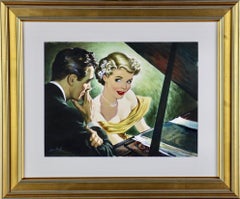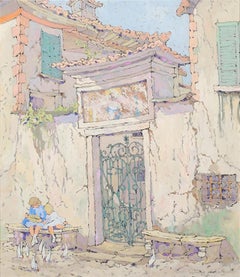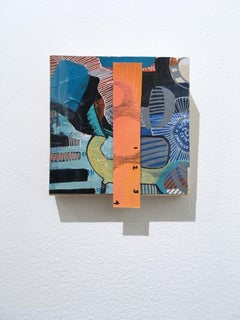George Garland Art
to
2
1
2
2
Overall Height
to
Overall Width
to
1
1
1
1
1
1
1
1
1
2
1
1
2
6,886
3,210
2,514
1,217
2
2
2
1
1
Artist: George Garland
"Journeyman Lover" Story Illustration, Saturday Evening Post
By George Garland
Located in Fort Washington, PA
Signed "George Garland" Lower Left by Artist
"To melt this frigid beauty required the services of an expert, someone with a wicked-and-compelling-way with women." Illustration for "...
Category
1940s George Garland Art
Materials
Gouache, Graphite
O MARA'S MUNICIPAL TAVERN - Saturday Evening Post Illustration
By George Garland
Located in Miami, FL
O MARA'S MUNICIPAL TAVERN - Saturday Evening Post Illustration
Supreme technical skill allows the artist to realistically capture an...
Category
1950s American Realist George Garland Art
Materials
Gouache
Related Items
The Gateway
By Eleanor Parke Custis
Located in New York, NY
Signed (lower right): ELEANOR PARKE CUSTIS
Category
20th Century American Realist George Garland Art
Materials
Paper, Gouache
My 80's Heart "Token 7" 2019, gouache, acrylic, graphite, panel, blue, orange
By Catherine Hart
Located in Jersey City, NJ
My 80's Heart "Token 7" 2019, gouache, acrylic, graphite, panel, blue, wood, orange
Category
2010s Contemporary George Garland Art
Materials
Acrylic, Gouache, Panel, Wood Panel, Illustration Board, Graphite
In Real Time, unique signed Abstract Expressionist painting compared to Matisse
By Steven Sorman
Located in New York, NY
Steven Sorman
In Real Time, 2003
Acrylic, gouache, gel medium, oil and beeswax collage painting on paper
48 × 34 inches
Signed and dated 2003; The frame also bears the original label...
Category
Early 2000s Abstract Expressionist George Garland Art
Materials
Mixed Media, Oil, Acrylic, Gouache, Gel Pen, Graphite
Illustration for the Brothers Grimm fairy tale "Rapunzel"
By Simon Kozhin
Located in Sempach, LU
In 2023, after 20 years, he returned to the illustrations of the Brothers Grimm fairy tale "Rapunzel". I wanted to write a couple of stories from a fairy tale, although the series ha...
Category
2010s American Realist George Garland Art
Materials
Paper, Watercolor
H 9.73 in W 11.74 in D 0.04 in
Circus Wagons
By Millard Sheets
Located in Los Angeles, CA
This watercolor is part of our exhibition America Coast to Coast: Artists of the 1930s
Circus Wagons, 1927, watercolor on paper, signed and dated lower left, 10 x19 ¾ inches (sight), provenance includes Stary-Sheets Art Gallery (Gualala, CA); J. Ralph & Louis Stone Foundation; presented in a newer metal frame behind glazing
About the Painting
Millard Sheets was only twenty years old and in his third year of studies at the Chouinard Art Institute when he painted Circus Wagons. Despite his youth, Sheets was already an accomplished artist who had publicly exhibited his work and won prestigious prizes. Within several years, he would have his first solo exhibition at one of Los Angeles’ premiere galleries and become a painting instructor at his alma mater. In Circus Wagons we already see Sheets deft handling of the watercolor medium and his interest in the California Scene. In this case, Sheets captures a back lot view of a traveling circus, a subject he sometimes returned to, including in a color screen print in the collection of the National Gallery. Sheets made a career by painting what he knew and observed firsthand. This approach allowed Sheets to capture with authenticity the details of each narrative. Even with a narrowly limited palette and an economy of brushstrokes, Sheets effectively depicts the southern California scene with its strong and mysterious shadows, as well as the workers and circus animals. Seen through the hindsight of his six-decade long career, Circus Wagons offers a fascinating insight into the early development of California Scene painting which would by the mid-1930s become the best recognized style on the West Coast.
About the Artist
Millard Sheets was the dean of California watercolorists. His list of accomplishments is so extensive that his entry in Who was Who in American Art is over forty lines. Born in Pomona, California, Sheets became a painter at an early age, winning a prize at the Los Angeles County Fair in 1918. By the mid to late-1920s, Sheets became a regular at art exhibitions in the western part of the United States, winning several additional prizes before he reached the age of twenty-five. Sheets studied at the prestigious Chouinard Art Institute from 1925 through 1929 with Frank Tolles Chamberlin and Clarence Hinkle and had his first solo show with Los Angeles’ Dalzell Hatfield Gallery in 1929. During the 1930s, Sheets was invited to exhibit at almost every major American Museum and in many ways, his work came to represent the California watercolor school...
Category
1920s American Realist George Garland Art
Materials
Watercolor
Fishermen, Bahamas (North Carolina artist)
By Frank Stanley Herring
Located in Wilton Manors, FL
Beautiful ca. 1935 painting by American artist, Frank Stanley Herring (1894-1966). Watercolor on heavy rag handmade paper measures 14.5 x 19 inches, 23 x 28 inches in original vintag...
Category
1930s American Realist George Garland Art
Materials
Handmade Paper, Watercolor
"Repetition" Chryssa, Greek Female Artist, Abstract, Neon Light Art Study
By Chryssa Vardea-Mavromichali
Located in New York, NY
Chryssa
Repetition
Signed lower right; titled on the reverse
Gouache, watercolor, charcoal, and graphite on paper
15 x 11 inches
Born and educated in Athens, Greece, Vardea Chryssa, known professionally as Chryssa, became a U.S. citizen and earned a reputation for her sculptured assemblages utilizing light from neon, and plexiglas combined with mixed media pieces. One of her pieces, Untitled Light Sculpture (1980) is 22 feet long and is installed in the atrium of a building at 33 Monroe Street in Chicago. It was programmed electronically to create changing patterns of reflected light through 900 feet of neon tubing.
Chryssa's sculptures with precision and definite form were a reaction against the prevalent Abstract Expressionism of the 1950s with its emphasis purely upon the artist's intent. In her work, the focus is on materials and the way they are shaped for specific use by craftsmen.
She got her early education in Athens, and first studied to be a social worker. She was then sent by the Greek Ministry of Social Welfare to the Dodecanese Islands and later to the Ionian Sea island of Zante, whose population had suffered great loss from earthquakes. Disillusioned that monies were being provided to restore monasteries but not to help other earthquake victims, Chryssa changed her life's direction to become a painter. In Athens, she studied art with Anghelos Prokopion.
Then she went to Paris, France, and studied briefly at the Academie Grande Chaumiere and associated with surrealists Andre Breton, Edgard Varese, and Max Ernst. In 1954, she moved to San Francisco, California for a year of study at the California School of Fine Arts, and there she first saw the work of Jackson Pollock, which had a freeing affect on her and inspired her to experiment with pure form. But later she reacted against action painting with her assemblage sculptures of controlled precision.
In 1955, Chryssa settled in New York City, and became the first artist to incorporate neon light tubing and commercial signs into sculpture. It is asserted that her "mature work grew out of the Greek experience, before and after World War II, wedded to the raucous letters, signs, symbols, and lights of Time Square, New York City" (Heller 125). In fact, she was so taken with the lights of Times Square that she unsuccessfully tried to get a job as a sign maker but was prevented by labor union rules. However, one of the members gave her sign-making lessons in his shop.
She first made Pop images such as depictions of automobile tires and cigarettes and in sculptures, utilized letters of the alphabet, ideas that predated similar images by Jasper Johns and Andy Warhol. Her first major work of interwoven light and letters was Times Square Sky of 1962, but she was dissatisfied because she thought the piece was too crowded. To create a sense of breathing, she inserted neon light, and for the first time, this material became an art medium.
From that time, she was prolific and created many variations based on the letters W and A. For her, a primary motivating factor was remaining cool or mentally collected amidst the onslaught of bombarding information and to process it through her creations in new ways so that nothing was repeated. She set up her own work place...
Category
Late 20th Century Abstract George Garland Art
Materials
Gouache, Graphite, Paper, Charcoal, Watercolor
1840 rare watercolor, Native American encampment, Western Indian Unknown artist
Located in Buffalo, NY
A rare mid 19th Century watercolor depicting Native Americans approaching a fort.
The subjects appear to be from a Northern Plains Tribes, and arre approaching a palisades style f...
Category
1840s American Realist George Garland Art
Materials
Paper, Gouache, Watercolor
Blue Blooms
By Liz Barber
Located in Napa, CA
My paintings are layered bursts of energy inspired by nature’s movement, blending the here and now with memories. Forms and lines fall into a sea of emotion. Shapes and reflections d...
Category
21st Century and Contemporary Contemporary George Garland Art
Materials
Canvas, Ink, Acrylic, Gouache, Graphite
My 80's Heart "Token 4" 2019, gouache, acrylic, graphite, panel, yellow, orange
By Catherine Hart
Located in Jersey City, NJ
My 80's Hart "Token 4" 2019, gouache, acrylic, graphite, panel, yellow, orange
Category
2010s Contemporary George Garland Art
Materials
Acrylic, Gouache, Panel, Wood Panel, Graphite
Colonel Bates Leads the 30th Colored Infantry at the Battle of the Crater
By Abbott Fuller Graves
Located in Costa Mesa, CA
Colonel Bates Leads the 30th Colored Infantry at the Battle of the Crater
Watercolor on Paper Circa 1903
15 ½ x 21 ½ Inches 25 ½ x 33 ½ Inches Framed
LR: Graves
This rare portrait of African American troops serving in battle during the Civil War depicts the 30th United States Colored Infantry at the Battle of the Crater, at Petersburg, Virginia. The regiment was composed of African American enlisted men commanded by white officers and was authorized by the Bureau of Colored Troops which was created by the United States War Department on May 22, 1863.
The Battle of the Crater, July 30th, 1864, was part of the Siege of Petersburg, fought between the Confederate Army of Northern Virginia, commanded by General Robert E. Lee and the Union Army of the Potomac, commanded by Maj. Gen. George G. Meade (under the direct supervision of the general-in-chief, Lt. Gen. Ulysses S. Grant).
At the top of the painting, Colonel Delevan Bates raises his saber to lead the charge of the 30th United States Colored Infantry. Bates was promoted to this command just prior to this battle, having served with distinction in the 121st New York Infantry at the Battles of Fredericksburg, Chancellorsville and Gettysburg. Though the Battle of the Crater would eventually be won by the Confederacy, it was here that Bates and 23 other troops would be award the United States highest award for bravery during combat, the Medal of Honor.
After weeks of preparation, on July 30, Union forces exploded a mine in Maj. Gen. Ambrose E. Burnside's IX Corps sector, blowing a gap in the Confederate defenses of Petersburg, Virginia. From this propitious beginning, everything deteriorated rapidly for the Union attackers. Unit after unit charged into and around the crater, where soldiers milled in confusion. Grant considered the assault "the saddest affair I have witnessed in this war." The Confederates quickly recovered and launched several counterattacks led by Brig. Gen. William Mahone. The breach was sealed off, and Union forces were repulsed with severe casualties. Brig. Gen. Edward Ferrero's division of black soldiers...
Category
Early 1900s American Realist George Garland Art
Materials
Paper, Watercolor
Untitled Geometric Abstraction - unique signed and inscribed work -framed
Located in New York, NY
Paul Pagk
Untitled Geometric Abstraction, 1989
Gouache and watercolor on paper
Signed, dated and inscribed "A Jacqueline".
Frame included
Excellent unique work on paper by contempora...
Category
1980s Abstract Geometric George Garland Art
Materials
Watercolor, Gouache, Pencil, Graphite
George Garland art for sale on 1stDibs.
Find a wide variety of authentic George Garland art available for sale on 1stDibs. You can also browse by medium to find art by George Garland in gouache, paint, watercolor and more. Not every interior allows for large George Garland art, so small editions measuring 11 inches across are available. Customers who are interested in this artist might also find the work of Kate Sammons, Paul Zimmerman, and Thomas Darsney. George Garland art prices can differ depending upon medium, time period and other attributes. On 1stDibs, the price for these items starts at $2,400 and tops out at $6,500, while the average work can sell for $3,900.



